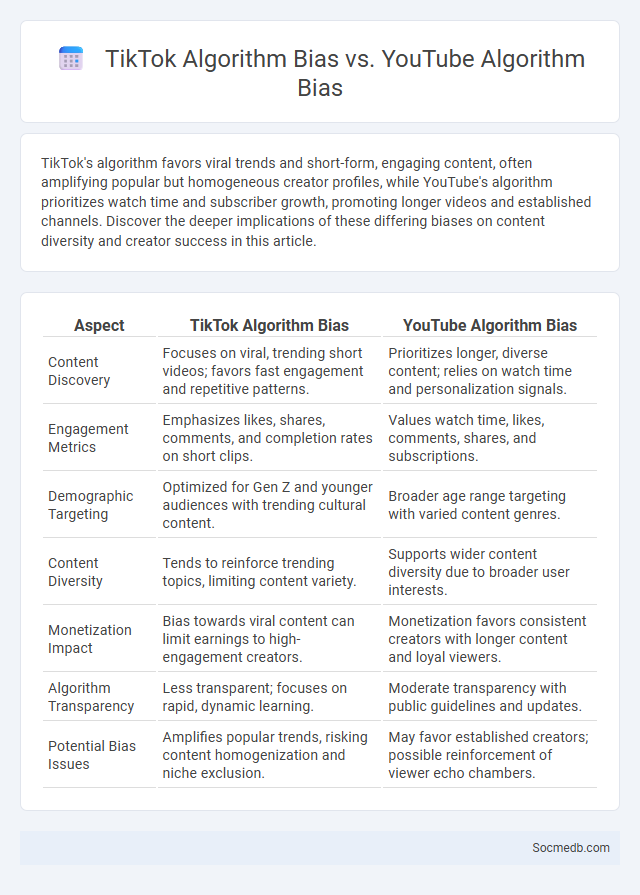
Photo illustration: TikTok Algorithm Bias vs YouTube Algorithm Bias
TikTok's algorithm favors viral trends and short-form, engaging content, often amplifying popular but homogeneous creator profiles, while YouTube's algorithm prioritizes watch time and subscriber growth, promoting longer videos and established channels. Discover the deeper implications of these differing biases on content diversity and creator success in this article.
Table of Comparison
| Aspect | TikTok Algorithm Bias | YouTube Algorithm Bias |
|---|---|---|
| Content Discovery | Focuses on viral, trending short videos; favors fast engagement and repetitive patterns. | Prioritizes longer, diverse content; relies on watch time and personalization signals. |
| Engagement Metrics | Emphasizes likes, shares, comments, and completion rates on short clips. | Values watch time, likes, comments, shares, and subscriptions. |
| Demographic Targeting | Optimized for Gen Z and younger audiences with trending cultural content. | Broader age range targeting with varied content genres. |
| Content Diversity | Tends to reinforce trending topics, limiting content variety. | Supports wider content diversity due to broader user interests. |
| Monetization Impact | Bias towards viral content can limit earnings to high-engagement creators. | Monetization favors consistent creators with longer content and loyal viewers. |
| Algorithm Transparency | Less transparent; focuses on rapid, dynamic learning. | Moderate transparency with public guidelines and updates. |
| Potential Bias Issues | Amplifies popular trends, risking content homogenization and niche exclusion. | May favor established creators; possible reinforcement of viewer echo chambers. |
Understanding Algorithmic Bias: A Primer
Algorithmic bias in social media platforms arises when algorithms systematically favor certain content, creators, or user behaviors, leading to unequal visibility and engagement. This bias often results from training data that reflects historical prejudices or unbalanced user interactions, impacting user experience and content diversity. Recognizing and addressing algorithmic bias is essential for fostering fair, inclusive online communities and ensuring that recommendation systems promote diverse and representative content.
TikTok Algorithm Bias: Key Issues and Examples
TikTok's algorithm bias has sparked significant concerns due to its opaque content recommendation system, which often prioritizes viral trends while marginalizing niche or minority voices. Key issues include reinforcement of gender, racial, and socioeconomic stereotypes, where content from underrepresented groups receives less visibility and engagement compared to mainstream creators. Examples such as the disproportionate suppression of videos by Black creators and the promotion of stereotypical content highlight the platform's need for greater transparency and algorithmic accountability.
YouTube Algorithm Bias: Notable Patterns and Concerns
YouTube algorithm bias manifests through preferential content promotion, often favoring sensational or popular videos, which can marginalize diverse voices and niche creators. Studies reveal the algorithm's tendency to amplify homogenous viewpoints, reinforcing echo chambers and limiting exposure to varied perspectives. This bias raises concerns about content diversity, misinformation proliferation, and equitable opportunities for all users on the platform.
How TikTok’s Algorithm Influences Content Exposure
TikTok's algorithm leverages user interactions such as likes, shares, and watch time to curate personalized content feeds, significantly influencing content exposure. By analyzing behavior patterns and preferences, the algorithm prioritizes engaging and relevant videos, boosting visibility for creators who quickly capture viewer attention. This dynamic system enhances viral potential by continuously adapting to trending content and user engagement metrics.
YouTube’s Recommendation Engine: Bias in Practice
YouTube's recommendation engine leverages machine learning algorithms to personalize video suggestions based on user behavior, watch history, and engagement metrics. This system often amplifies certain types of content by prioritizing videos that drive higher watch time, which can inadvertently promote sensational or biased material. Studies reveal that this bias in practice may reinforce echo chambers, influencing user perceptions and contributing to information polarization across digital social networks.
Comparing TikTok and YouTube: Sources of Algorithmic Bias
TikTok and YouTube both utilize complex algorithms that can lead to algorithmic bias by amplifying specific content types based on user engagement patterns and creator demographics. TikTok's short-form video format prioritizes rapid content consumption, which can skew recommendations toward trending or sensational content, while YouTube's longer videos and broader category spectrum allow for niche interests but may reinforce echo chambers. Understanding these differences helps you navigate platform biases and curate a more balanced digital experience.
Impact of Algorithmic Bias on User Experience
Algorithmic bias in social media platforms can significantly distort Your user experience by prioritizing certain content while suppressing others based on flawed data or prejudiced patterns. This selective exposure affects the diversity of information, potentially reinforcing echo chambers and limiting access to balanced viewpoints. Understanding the impact of these biases helps You critically engage with content and seek more inclusive digital interactions.
Social and Cultural Consequences of Platform Bias
Social media platforms' algorithmic biases shape user experiences by amplifying certain cultural narratives while marginalizing others, influencing public opinion and social norms. These biases can reinforce stereotypes, deepen social divides, and affect marginalized communities' representation and visibility online. The resulting echo chambers and filter bubbles contribute to polarization, impacting collective understanding and societal cohesion.
Strategies to Mitigate Algorithmic Bias on Social Media
Strategies to mitigate algorithmic bias on social media include implementing transparency frameworks that disclose how algorithms prioritize content and employing diverse training data sets to reduce systemic biases. Incorporating regular audits with bias detection tools and involving multidisciplinary teams enhances fairness in content moderation and recommendation systems. Promoting user feedback mechanisms allows continuous refinement of algorithms to better reflect diverse user perspectives and reduce discriminatory outcomes.
The Future of Fairness in Content Recommendation Algorithms
Content recommendation algorithms are increasingly pivotal in shaping user experience on social media platforms by curating personalized feeds that reflect diverse interests and values. The future of fairness in these algorithms involves integrating advanced bias detection methods and transparent frameworks that ensure equitable content distribution across demographics. Employing machine learning models with fairness constraints and regularly auditing algorithmic outputs will help mitigate discrimination and promote inclusive online environments.
 socmedb.com
socmedb.com